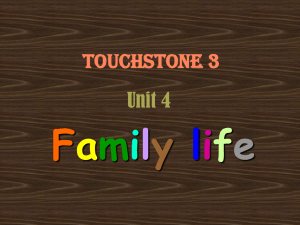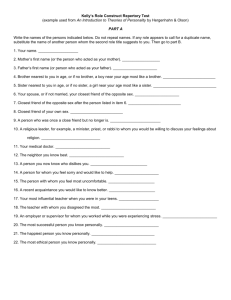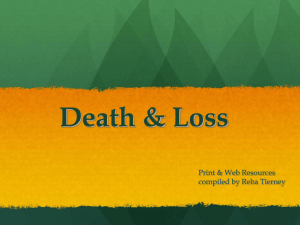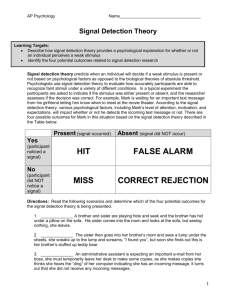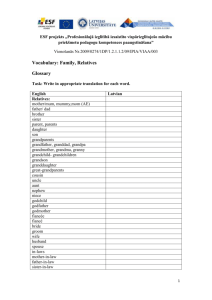Family
advertisement
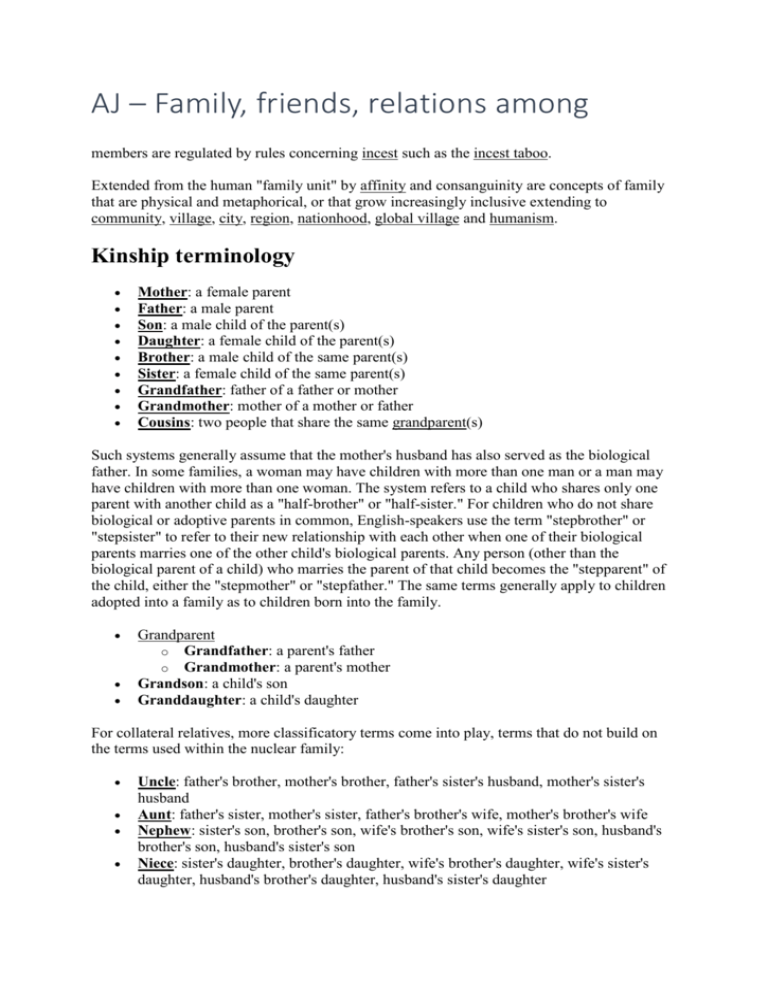
AJ – Family, friends, relations among members are regulated by rules concerning incest such as the incest taboo. Extended from the human "family unit" by affinity and consanguinity are concepts of family that are physical and metaphorical, or that grow increasingly inclusive extending to community, village, city, region, nationhood, global village and humanism. Kinship terminology Mother: a female parent Father: a male parent Son: a male child of the parent(s) Daughter: a female child of the parent(s) Brother: a male child of the same parent(s) Sister: a female child of the same parent(s) Grandfather: father of a father or mother Grandmother: mother of a mother or father Cousins: two people that share the same grandparent(s) Such systems generally assume that the mother's husband has also served as the biological father. In some families, a woman may have children with more than one man or a man may have children with more than one woman. The system refers to a child who shares only one parent with another child as a "half-brother" or "half-sister." For children who do not share biological or adoptive parents in common, English-speakers use the term "stepbrother" or "stepsister" to refer to their new relationship with each other when one of their biological parents marries one of the other child's biological parents. Any person (other than the biological parent of a child) who marries the parent of that child becomes the "stepparent" of the child, either the "stepmother" or "stepfather." The same terms generally apply to children adopted into a family as to children born into the family. Grandparent o Grandfather: a parent's father o Grandmother: a parent's mother Grandson: a child's son Granddaughter: a child's daughter For collateral relatives, more classificatory terms come into play, terms that do not build on the terms used within the nuclear family: Uncle: father's brother, mother's brother, father's sister's husband, mother's sister's husband Aunt: father's sister, mother's sister, father's brother's wife, mother's brother's wife Nephew: sister's son, brother's son, wife's brother's son, wife's sister's son, husband's brother's son, husband's sister's son Niece: sister's daughter, brother's daughter, wife's brother's daughter, wife's sister's daughter, husband's brother's daughter, husband's sister's daughter When additional generations intervene (in other words, when one's collateral relatives belong to the same generation as one's grandparents or grandchildren), the prefixes "great-" or "grand-" modifies these terms. Also, as with grandparents and grandchildren, as more generations intervene the prefix becomes "great-grand-," adding an additional "great-" for each additional generation. Most collateral relatives have never had membership of the nuclear family of the members of one's own nuclear family. Cousin: the most classificatory term; the children of aunts or uncles. Cousins of an older generation (in other words, one's parents' first cousins), although technically first cousins once removed, are often classified with "aunts" and "uncles." Similarly, a person may refer to close friends of one's parents as "aunt" or "uncle," or may refer to close friends as "brother" or "sister," using the practice of fictive kinship. Englishspeakers mark relationships by marriage (except for wife/husband) with the tag "-in-law." The mother and father of one's spouse become one's mother-in-law and father-in-law; the female spouse of one's child becomes one's daughter-in-law and the male spouse of one's child becomes one's son-in-law. The term "sister-in-law" refers to three essentially different relationships, either the wife of one's sibling, or the sister of one's spouse, or, in some uses, the wife of one's spouse's sibling. "Brother-in-law" expresses a similar ambiguity. The terms "half-brother" and "half-sister" indicate siblings who share only one biological or adoptive parent. Family types Sociologists have a special interest in the function and status of these forms in stratified (especially capitalist) societies. The term "nuclear family" is commonly used, especially in the United States, to refer to conjugal families. Sociologists distinguish between conjugal families (relatively independent of the kindred of the parents and of other families in general) and nuclear families (which maintain relatively close ties with their kindred). The term "extended family" is also common, especially in United States. This term has two distinct meanings. First, it serves as a synonym of "consanguinal family" (consanguine means "of the same blood"). Second, in societies dominated by the conjugal family, it refers to "kindred" (an egocentric network of relatives that extends beyond the domestic group) who do not belong to the conjugal family. These types refer to ideal or normative structures found in particular societies. Any society will exhibit some variation in the actual composition and conception of families. Less-known family types The term blended family or stepfamily describes families with mixed parents: one or both parents remarried, bringing children of the former family into the new family. Also in sociology, traditional family refers to "a middleclass family with a bread-winning father and a stay-at-home mother, married to each other and raising their biological children," and nontraditional to exceptions from this rule. Most of the US households are now nontraditional under this definition. Size Natalism is the belief that human reproduction is the basis for individual existence, and therefore promotes having large families. Many religions, e.g., Islam, Christianity and Judaism, encourage their followers to procreate and have many children, however many of them also propound stewardship and responsibility to care for the environment and society. In recent times, however, there has been an increasing amount of family planning and a following decrease in the total fertility rate in many parts of the world, in part due to improvements in health care. Friendship Friendship is a relationship between two or more people who hold mutual affection for each other. Friendships and acquaintanceship (známost) are thought of as spanning across the same continuum. The study of friendship is included in the fields of sociology, social psychology, anthropology, and philosophy. Various academic theories of friendship have been proposed, including social exchange theory, equity (spravedlnost) theory, relational dialectics, and attachment (oddanost) styles. The value of friendship The value of friendship may be expressed as the benefit gained from a friend who is consistently demonstrating any of the following: The tendency to desire what is best for the other Sympathy and empathy Honesty, even in situations where it may be difficult for others to speak the truth Mutual understanding and compassion Enjoyment of each other's company Trust in one another Positively strong, deep, close reciprocity, mutuality The ability to be oneself, express one's feelings and make mistakes without fear of judgment. Friendships in adulthood Just like adolescents, relationships with friends are important to older adults. Friends contribute to our satisfaction, give us a sense of belonging, competence, and self-worth. Friendship involves: Enjoyment: spending time doing things together and sharing life experiences Trust: believing that our friends act on our behalf Respect and understanding: believing that our friends have the right to their own opinions Mutual assistance: helping and supporting our friends and having them help us Confiding: sharing confidential matters with our friends Types of friendships Friends are people we know and trust, and who are special to us socially and emotionally. Friends are usually chosen among people who are considered the same as us. The people adults select as friends tend to be those who: have grown up together have similar occupations have children the same age have similar interests are the same general age and the same gender List of friendships There are many types of friendship. Here are the most important. Associate - not a true friend – sharing of emotional ties is absent. Example: a co-worker Best friend (or close friend) - someone who shares extremely strong interpersonal ties with as a friend Blood brother or blood sister - people related by birth Family friend - friendship extended to family members of the friends Imaginary friend - non-physical friend created by a child or even an adult Pen pal - people who have a relationship via postal correspondence


